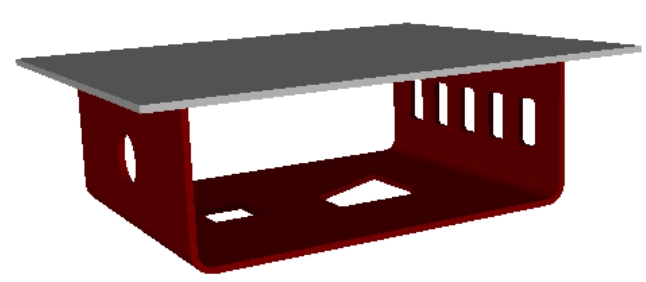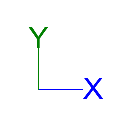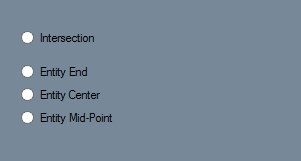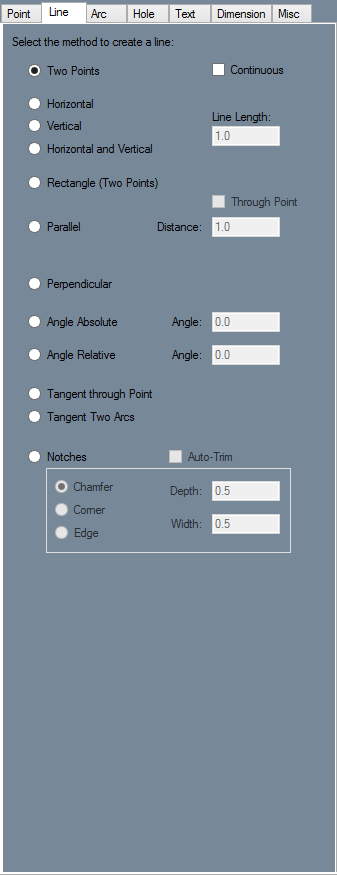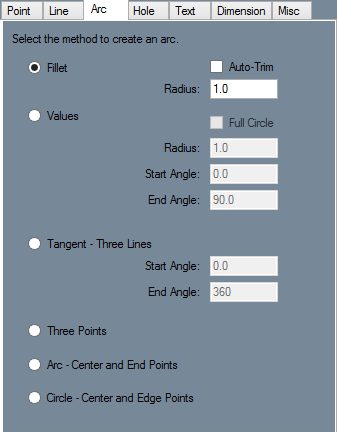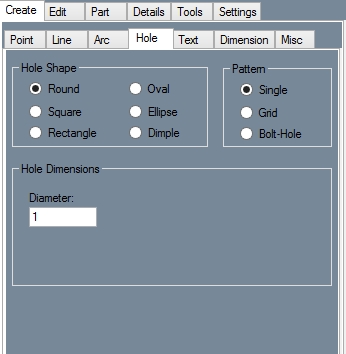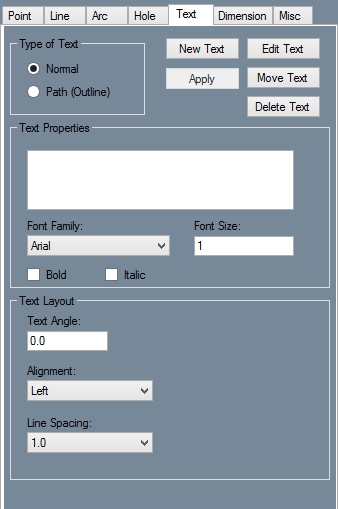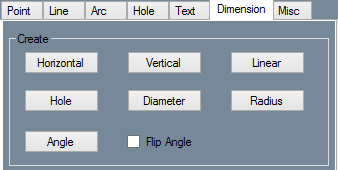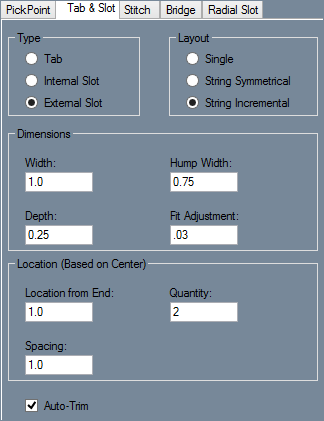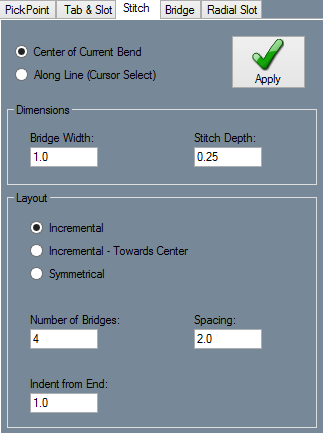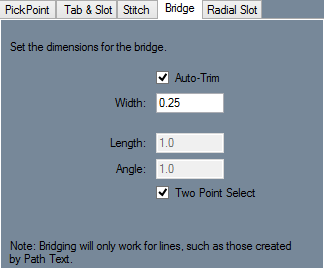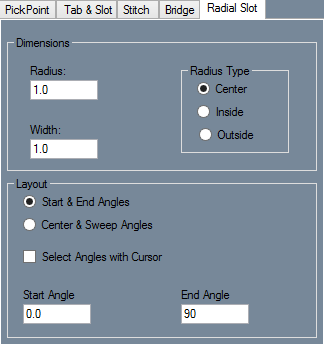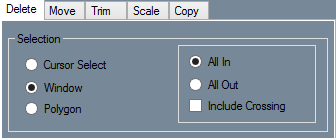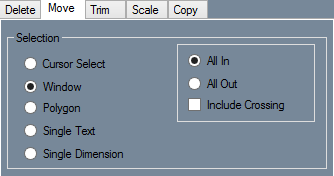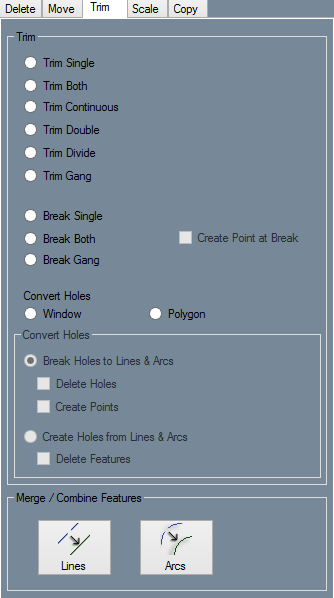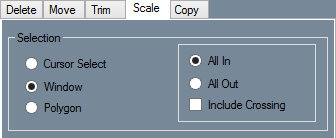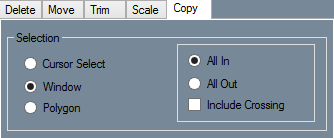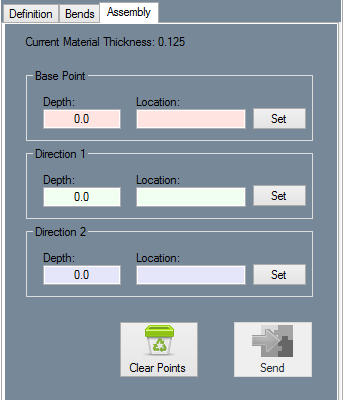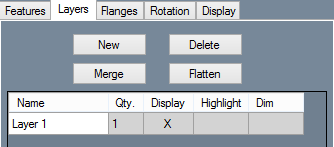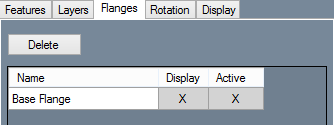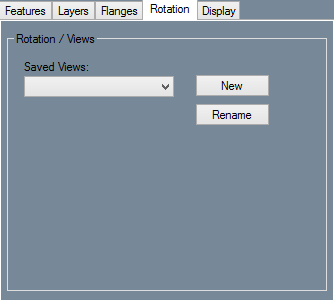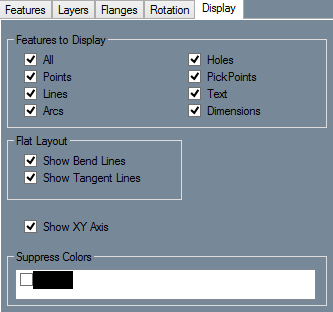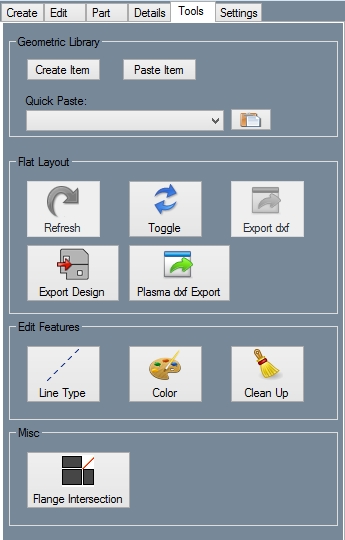Plate
Due to its length, the Sheet Metal Module Guide has a Table of Contents to accommodate the user.
The sheet metal module offers the ability to create designs made of sheet metal using a wide variety of tools and functions. In order to keep these tools and functions under one's control, this guide will assist users by explaining the functions of each button and mode of operation.
The sheet metal interface allows bent and straight sheet metal parts to be assembled together. Parts can also be cut and the wrappers for these cuts can be printed out here.
To open a new plate design:
1.) Go to the File menu, select New-->Plate.
2.) Click the New Plate icon ![]() at the top of the window.
at the top of the window.
...OR
3.) Select the Plate option from the Task Menu that appears when the software starts up, when all designs are closed, or through the view menu.
Contents
Icon Toolbar
- The Tool Bar is the row of icons just below the Main Menu Bar.
Click the New Part icon ![]() to open the create new menu. This menu will allow you to choose a new part designer interface and begin a new part design.
to open the create new menu. This menu will allow you to choose a new part designer interface and begin a new part design.
Click the New Assembly icon ![]() to open a new assembly design. See the Assembly page for further information on creating an assembly.
to open a new assembly design. See the Assembly page for further information on creating an assembly.
Click the New Plate icon ![]() to open a new plate design. See the Plate page for further information on designing a plate.
to open a new plate design. See the Plate page for further information on designing a plate.
Click the New Header icon ![]() to open a new header design. See the Header Design page for further information.
to open a new header design. See the Header Design page for further information.
Click the Open icon ![]() to open a part, assembly, plate, or header file.
to open a part, assembly, plate, or header file.
Click the Save icon ![]() to save the current active window's progress. If the current window is a new and hasn't been saved previously, the part will need to be given a name and location. Click 'Save' in the Save window to save.
to save the current active window's progress. If the current window is a new and hasn't been saved previously, the part will need to be given a name and location. Click 'Save' in the Save window to save.
Click the Print icon ![]() to print out an image of the current view of the plate design in the display.
to print out an image of the current view of the plate design in the display.
Click the Print Preview icon ![]() to view a preview of the plate design image print out.
to view a preview of the plate design image print out.
Click the Solidworks icon ![]() to import a part file from Solidworks that has been sent to Bend-Tech.
to import a part file from Solidworks that has been sent to Bend-Tech.
Click the Display menu ![]() to alternate between design, defined, 3D wireframe, 3D shaded, and flat layout mode. See the design mode page for information on each of these options.
to alternate between design, defined, 3D wireframe, 3D shaded, and flat layout mode. See the design mode page for information on each of these options.
Click the Refresh icon ![]() to refresh the part display.
to refresh the part display.
Click the Home button ![]() to reset the 3D part display to its original default view.
to reset the 3D part display to its original default view.
Click the Zoom button ![]() to zoom all the way in on the current view of the 3D part display and fit it to the display frame.
to zoom all the way in on the current view of the 3D part display and fit it to the display frame.
Color: Click the color icon to change the color of future point and line features in the plate design display.
Line Type: Any new lines that are placed will be the type of line that is selected in the Line Type drop down menu. Click the small picture of a line to the right of the phrase "Line Type" to open the Line Type drop down menu.
Layer: Use the Layer drop down menu to select a layer. You can only work on the currently selected layer.
Flange: To switch the active flange, use the Flange drop down menu.
Create
Origin
The "Origin" is the cross section between the X and the Y located in the display area on the right of the screen. This is a great place to start a project as a first reference point. For users who have Bend-Tech and are using Sheet Metal as a module, think of this Origin as a Tri-Star.
Point
- Cursor: Select the "Cursor" option and pick anywhere on the screen to click and place a point. The point will be placed at the exact location of your cursor and will not reference any other entities while being placed. The point will not be highlighted blue before placement.
- Incremental: Select the "Incremental" function, provide X and Y coordinates into the "X:" and "Y:" value fields and select a reference point in the display area. X is the horizontal distance and Y is the vertical distance from the reference point. (Note: A negative (-) X value will place the point to the left of the reference point. A negative (-) Y value will place the point below the reference point.) The point will be highlighted in blue while the reference point is being chosen.
- Angle: Select the "Angle" option under the point tab, enter the distance from the reference point in the "Distance" field and enter an angle in the "Angle" field. If the "Angle" field is set to 0°, the new point will be created directly to the right of the reference point. To place the new point, click on a point to use as a reference point. The point will be highlighted in blue while the reference point is being chosen.
-
Absolute: Select the "Absolute" option and enter X and Y coordinates into the "X:" and "Y:" fields and click the "Submit"
 button to place the point. The reference point will always be (0,0) (or the origin that shows X and Y in the display area).
button to place the point. The reference point will always be (0,0) (or the origin that shows X and Y in the display area). - Intersection: Select the "Intersection" option followed by two intersecting lines in order to place a point at the intersection of the two lines.
- Entity End: Select the "Entity End" option followed by an object or line in the display area to place an end point of that object. The point will be placed at the end that you click closest to. The point will be highlighted in blue before the object is chosen.
- Entity Center: Select the "Entity Center" option followed by an object or line in the display area to place a center point on that object. The point will be placed directly in the center of the object highlighted. The point will be highlighted in blue and the point will be visible before the object is chosen. (Note: This option is not meant to find the center of self-created objects like flanges, but rather lines, arcs, text, tabs, slots along with holes).
- Entity Mid-Point: Select the "Entity Mid-Point" option followed by an object or line in the display area to place a mid-point on that object. The point will be placed directly in the center of the section of the object highlighted. The point will be highlighted in blue and the point will be visible before the object is chosen. (Note: This option is not meant to find the center of self-created objects like flanges, but rather lines, arcs, text, tabs, slots along with holes).
Line
- Two Points: Select the "Two Points" option, click on a point in the display area and it will turn into a blue circle. Now click on a second point to create a line between the two points. Enable Continuous mode by clicking the "Continuous" checkbox. This will automatically start new lines with the first point set as the end of the last line. To stop drawing lines while in Continuous mode click "Cancel" in the "Activity" section.
- Horizontal: Select the "Horizontal" option and set the length of the line by entering a value in the "Line Length:" field to create a horizontal line. Place the line by clicking a point in the display area. The mid-point of the line will be centered on the point you select.
- Vertical: Select the "Vertical" option and set the length of the line by entering a value in the "Line Length:" field to create a vertical line. Place the line by clicking a point in the display area. The mid-point of the line will be centered on the point you select.
- Horizontal and Vertical: Select the "Horizontal and Vertical" option to create two intersecting lines of equal length and set the line lengths using the "Line Length:" field. Click on a point to place the lines. Both lines will be placed with the intersection directly over the point you select.
- Rectangle: Select the "Rectangle (Two Points)" option, click a point in the display area and creating a point will cause it to turn into a blue circle. A blue rectangle will be drawn between the selected point and the point nearest the cursor. Move the cursor near the intended second point and make sure the blue rectangle is correct. Click to create the rectangle.
- Parallel: Select "Parallel" so you can either enter the distance between the parallel line and the reference line or use the "Through Point" feature. If a distance is entered and the Through Point checkbox is not selected, click a line to set it as the reference line. After picking the reference line, select which side the parallel line will be placed on by clicking on that side of the reference line. If the Through Point checkbox is selected you must first select a reference line, followed by a point that the parallel line will pass through.
- Perpendicular: Select the "Perpendicular" option to create a line perpendicular to previously established line. Set the length of the perpendicular line using the "Line Length:" field. Then, click a line in the display area to set it as the reference line. The side you click on will determine the direction of the line. Click on any point to place the perpendicular line there.
- Angle Absolute: Select the "Angle Absolute" option to create a line in the display area with a desired angle. First, enter the desired length in the "Line Length:" field and the desired angle in the "Angle:" field. Click on a point to place the Line there.
- Angle Relative: Select the "Angle Relative" option and enter the length of the desired line in the "Line Length:" field and the relative angle in the "Angle:" field. Click on a line to use as a reference line and click on a point to use as a starting point for the new line. The angle of the line will be the sum of the angle of the reference line and the value entered in the Angle field.
- Tangent through Point: Select the "Tangent through Point" option to create a line connected to an arc by clicking near the side of the arc that the line will be drawn to. Click on a point away from the arc to create the line.
- Tangent Two Arcs: Select the "Tangent Two Acrs" option to add a line between two arcs by clicking near the side that the line will be drawn to. Select a second arc to create a line that attaches to the tangent of that arc.
- Notches: Select the "Notches" option and which type of notch you would like to add by clicking either "Chamfer, Corner, or Edge". If adding a Chamfer or Corner, input the desired depth into the "Depth:" field. To add the notch, click on a line and another line that you want the notch to connect to. On the second line, the location that is selected determines which direction the notch faces. Click on the end closest to the direction you want it to face. To add an Edge, you need to input both the Depth and Width. This will create a rectangle with the depth and width that you selected which can be added to the edge of a line. The edge will be added to the closest line and will be placed on the nearest end. An edge can be added to either side of the end of a line by clicking on that side. Check the Auto-Trim box to automatically cut off any part of a line that extends past a notch.
Arc
- Fillet: Select the "Fillet" option and input the desired radius of the filleted arc into the "Radius:" field. Click on the first line, which will turn blue. A blue arc will come off the first line and connect with whatever line is nearest to the cursor. Change the direction of the fillet by moving the cursor to the other side of the first line. Click to place the fillet. If the "Auto-Trim" checkbox is checked, any part of either line that extends past the fillet will be cut off.
- Values: Select the "Values" option and input the "Radius:, Start Angle:, and End Angle:" of the arc into their respective fields. Click on a point to place the arc with its center directly over that point. Check the "Full Circle" checkbox to automatically set the start angle at "0" and the end angle at "360", creating a full circle.
- Tangent - Three Lines: Select the "Tangent - Three Lines" option and set the start and end angle of the arc using the "Start Angle:" and "End Angle:" fields. Click on three lines within the part, in any order, to create an arc that uses those three lines as tangent lines.
- Three Points: Select the "Three Points" option and pick three points that lie within the desired arc. The first and third points will be end-points. The second point will be on the arc and will define the radius of the arc. If the first and third points are the same point, a circle will be drawn between the first and second point.
- Arc - Center and End Points: Select the "Arc - Center and End Points" option and click on the point that will lie in the center of the intended arc. Click on another point to create the first end point. A blue arc will be drawn from the first end point to the point on the arc closest to the cursor. Move the cursor until the second end point is in the desired location and click to place the arc.
- Circle - Center and Edge Points: Select the "Circle - Center and Edge Points" option and click on a point to set it as the center point. A blue circle will be drawn with a radius equal to the distance to the point nearest to the cursor. Move the cursor to the desired point and click to place the circle.
Hole
Hole Shape
- Round: Select Round, enter a diameter in the Diameter field, and click on a flange to place a round hole at that point.
- Oval: Select Oval, enter a width and length in the Width and Length field, and enter an angle for the hole in the Angle field. Click on a PickPoint or endpoint to place an oval hole at that point.
- Square: Select Square, enter a width in the width field, and enter an angle for the hole in the Angle field. If you want to automatically round the corners of the square, you can enter a value in the Corner Radius field. Entering 0 in the Corner Radius field will result in square corners. Click on a PickPoint or endpoint to place an oval hole at that point.
- Ellipse: Select Ellipse and click on the Length button. A window will appear with a diagram of a cylinder going through a plate. You must enter the width and angle of this cylinder in the Diameter of Cylinder and Angle of Cylinder fields. The length of the hole will be calculated automatically. Click the Copy button, close the window, and paste the value into the Length field by clicking in the field and hitting the Control key and the "V" key at the same time. Enter the same width and angle that you used before and click on a point to place an elliptical hole at that location.
- Rectangle: Select Rectangle and enter a width and height in the Width and Height fields. Enter an angle in the Angle field and click on a point to place a rectangular hole at that location.
- Dimple: A dimple is a round hole that is slightly raised, so that the plate around the edges of the hole slope up towards the hole. The Inner Diameter is the section that will actually be cut out of the plate. The Outer Diameter is the area of plate surrounding the hole that slants up towards the hole. Enter an inner and outer diameter and a height in the respective fields. Select Up or Down in order to set whether the dimple is raised or pressed into the plate. Click on a point to place a dimple at that location.
Pattern
- Single: To place a single hole at the location that you click, select Simple.
- Grid: To place a grid of holes, select grid. You can place the grid at an angle by entering a value in the Angle field. Enter the number of rows and columns in the grid in the Number of Rows and Number of Columns fields. Enter the spacing between each row in the Row Spacing field and enter the spacing between each column in the Column Spacing field.
- Bolt-Hole: To create a series of holes along an arc, select Bolt-Hole. Enter the radius of the arc in the Radius field. Enter the angle where the series of holes will start in the Start Angle field. To rotate holes as they are placed check the Holes rotate with sweep checkbox. Enter the angular distance between each hole in the Spacing Angle field. Enter the number of holes that you want to place in the Number of Holes field. Click on a point to place the center of the arc at that location.
Text
Creating Text
- Normal: Click the New Text button and type the text that you want to place in the empty field in the Text Properties area. Select a font using the Font Family drop down menu and enter a size factor in the Font Size field. Enter the angle that the text will be placed at in the Text Angle field. Use the Alignment drop down menu to set the text alignment and use the Line Spacing drop down menu to set the spacing between lines of text.
- Path (Outline): When using Path (Outline) to create text, any text you place will be constructed out of lines and arcs which can be used as if they were user placed lines and arcs. The Text Properties area is the same as if you were creating normal text, however the Text Layout area is different. In the Text Angle field enter an angle for the text to be placed at. Enter the spacing between each letter in the Letter Spacing field. To Stretch the string of text horizontally, enter an amount to stretch by in the Horizontal Stretch field. Use the Style drop down menu to choose whether the text is straight or curved. If it is curved up or down, you can enter the radius of the arc that the text is curved around in the Arc Radius field. Use the Precision drop down menu to select the level of detail that the text is drawn with. If you want to create curved but keep each individual letter upright, check the Static Letter Angles checkbox.
Editing Text
- Edit: To edit an existing string of text, click on the Edit button and click on a previously placed piece of text. Make any changes to the Text Properties and Text Layout areas and click the Apply button.
- Move: To move text, click the move button and click on a string of text. Click on a point to place the text at that location.
- Delete: To delete text, click on the Delete button and click on a string of text.
Dimension
Create
Click the Horizontal button and click two points in the display window. A Dimension, along with dimension and extension lines, will appear and move with the cursor. Move the Dimension to the desired location using the cursor and click to place it.
Click the Vertical button and click two points in the display window. A Dimension, along with dimension and extension lines, will appear and move with the cursor. Move the Dimension to the desired location using the cursor and click to place it.
Click the Linear button and click two points in the display window. A Dimension, along with dimension and extension lines, will appear and move with the cursor. Move the Dimension to the desired location using the cursor and click to place it.
Click the Hole button and click on a hole. The radius of the hole, along with an abbreviated version of the name of its shape, will be drawn and bound to the cursor. Move the cursor until the dimension is in the desired location and click to place it.
Click on the Diameter button. Click on a circle in the display window. A dimension and dimension line will appear in the circle and be bound to the cursor. If the cursor is moved out of the circle an extension line will be drawn in between the circle and the dimension. Move the cursor to reposition the dimension and click to place it.
Click the Radius button and click an arc. The radius of the arc, along with a dimension, will be drawn and bound to the cursor. Move the cursor until the dimension is in the desired location and click to place it.
Click the Angle button. Click the outside point of the first line. See the picture to the right for an example of outside and inside points. Your points can be endpoints of a line or individual points. Click the inside point of the first line. Now click the outside and inside points of the second line. The dimension, as well as a dimension arc and two extension lines, will be bound to the cursor. Move the cursor until the dimension is in the desired location and click to place it. To measure the reverse of the angle, click the Flip Angle checkbox.
Edit
Click on the Move button and click on a dimension. The dimension will now move with the mouse and can be repositioned. Click to place the dimension.
Click on the Delete button and click on a dimension to delete it.
Click on Edit Value and click on a dimension. A window will pop up and ask for a new display value for the dimension. Enter a value and click on the OK button.
Click on the Properties button and click on a dimension. Make any necessary changes to the settings by clicking on a field in the Value column. Standoff, Offset, Text Size, Arrow Width, and Arrow Height can all be changed by typing a new value to replace the existing value. Arrow Type, Distance Tolerance, and Angle Tolerance can be changed by using the drop down menus that appear when their value boxes are clicked. Dim Color, Ext Color, and Text Color can be changed by clicking on their value boxes and selecting the desired color in the color window that appears. To update the dimension with the new settings click on the Apply button.
Click on the Properties button and click on a dimension. Make all necessary changes to the dimensions settings. Click Apply to apply the settings to the dimension.
Make any necessary changes to the settings and click on the Apply All button. All dimensions will be updated with these settings.
- Show Number of Holes: Click on this checkbox to display the number of similar holes when creating hole dimensions.
- Display Feet: Click on this checkbox to display feet and inches rather than exclusively inches.
Settings
Click on the box next to Standoff in the value column and enter a new value to replace the existing one. Use the Properties and Apply buttons to update a single dimension with the new value, or use Apply All to update all dimensions.
Click on the box next to Offset in the value column and enter a new value to replace the existing one. Use the Properties and Apply buttons to update a single dimension with the new value, or use Apply All to update all dimensions.
Click on the box next to Text Size in the value column and enter a new value to replace the existing one. Use the Properties and Apply buttons to update a single dimension with the new value, or use Apply to All to update all dimensions.
Click on the box next to Arrow Width in the value column and enter a new value to replace the existing one. Use the Properties and Apply buttons to update a single dimension with the new value, or use Apply to All to update all dimensions.
Click on the box next to Arrow Height in the value column and enter a new value to replace the existing one. Use the Properties and Apply buttons to update a single dimension with the new value, or use Apply to All to update all dimensions.
Click on the box next to Arrow Type in the value column and select an option from the drop down menu. Use the Properties and Apply buttons to update a single dimension with the new arrow type, or use Apply to All to update all dimensions.
Click on the box next to Distance Tolerance in the value column and select an option from the drop down menu. Use the Properties and Apply buttons to update a single dimension with the new value, or use Apply All to update all dimensions.
Click on the box next to Angle Tolerance in the value column and select an option from the drop down menu. Use the Properties and Apply buttons to update a single dimension with the new value, or use Apply All to update all dimensions.
Click on the box next to Dim Color in the value column. A window will appear where a new color can be chosen. Click on a color and click OK. To learn how to define custom colors see the Color page. Use the Properties and Apply buttons to update a single dimension with the new value, or use Apply All to update all dimensions.
Click on the box next to Ext Color in the value column. A window will appear where a new color can be chosen. Click on a color and click OK. To learn how to define custom colors see the Color page. Use the Properties and Apply buttons to update a single dimension with the new value, or use Apply All to update all dimensions.
Click on the box next to Text Color in the value column. A window will appear where a new color can be chosen. Click on a color and click OK. To learn how to define custom colors see the Color page. Use the Properties and Apply buttons to update a single dimension with the new value, or use Apply All to update all dimensions.
Misc
PickPoint
Enter a depth in the Depth field. The Depth is the distance on the Z axis from the plate. Click a point to place the PickPoint at the X and Y coordinates of that point.
Tab & Slot
Select the feature that you would like to create in the Type area. In the Layout area, select Single to create a single tab or slot, String Symmetrical to create an evenly spaced series of tabs or slots along a line, or String Incremental to place a series of tabs or slots starting at one end of a line and spaced incrementally by a user selected amount. Enter the width of the tabs or slots in the Width field and enter their depth in the Depth field. Enter the amount that tabs will be undersized and slots will be oversized in the Fit Adjustment field. If you are creating an external slot, enter the width of the humps used to create the slots in the Hump Width field. Enter the distance from the end of the line to the first tab or slot in the Location from End field. If you are using String Symmetrical or String Incremental, enter the number of tabs or slots you want to create in the Quantity field. If you are using String Incremental, enter the spacing between each tab or slot in the Spacing field. Use the Auto-Trim checkbox to toggle automatic trimming when creating tabs and slots.
Stitch
Select either Center of Current Bend or Along Line (Cursor Select). If you select Center of Current Bend, you must have a bend selected as the current flange. Enter the width of the bridges and the depth of each stitch in the Bridge Width and Stitch Depth fields. Select Incremental, Incremental - Towards Center, or Symmetrical in the Layout area. If Incremental is selected, enter the number of bridges and spacing between each bridge in the Number of Bridges and Spacing fields. Enter the distance from the edge of the plate to the first stitch in the Indent from End field. Incremental - Towards Center works exactly like Incremental, except that the stitches will start at each end and move towards the center. If you are using Symmetrical, the stitches will be evenly spaced along the bend. Enter the number of bridges in the Number of Bridges field. Enter the distance between the edge of the plate and the first stitch in the Indent from End field.
Bridge
If Two Point Select is selected, enter a width in the Width field. Click the start and end points of the bridge to create it. To turn off automatic trimming, uncheck the Auto-Trim checkbox. To manually enter the distance and angle of the end point of the bridge, uncheck the Two Point Select checkbox and enter the values in the Length and Angle fields. Click a point to set it as the start point. Bridges can be made through any line, including lines from path text.
Radial Slot
Enter the radius of the arc in the Radius field. Select whether the radius is being measured from the center, inside, or outside in the Radius Type area. Enter the width of the slot in the Width field. To determine the length of the slot, select either Start & End Angles or Center & Sweep Angles from the Layout area.
- Start & End Angles: Enter a start and end angle for the radial slot in the Start Angle and End Angle fields. Click a point to place the center of the arc at that location. Alternatively, you may check the Select Angles with Cursor checkbox and manually select the center and end points of the arc. To do so, check the Select Angles with Cursor checkbox, click a point to set it as the center of the arc, click a point to set it as the beginning of the arc, and move the cursor until the slot is drawn correctly. Click to place the slot.
- Center & Sweep Angles: Enter the angle that will be used as the center of the radial slot in the Center Angle field. Enter the total angular length of the slot in the Sweep Angle field. If Select Angles with Cursor is checked, click a point to set it as the center of the arc. Click another point to set it as the center of the slot. Move the cursor until the slot looks correct and click to place the radial slot.
Edit
Delete
Selection
Use the Selection tools to select an entity or multiple entities and delete them. Items will be deleted instantly upon selection. See the Selection page for information about the Selection tools.
Features to Include
Select which features to include. When selecting multiple entities with a Window or Polygon selection, groups of entities can be unselected to prevent them from being deleted. See the Features to Include page for more information.
Colors to Include
Select which colors to include. A color can be unselected in order to prevent all entities of that color from being deleted. See the Colors to Include page for more information.
Move
Selection
Select entities using the Selection tools. For more information on selection see the Selection page.
Features to Include
Click on a checkbox to unselect that feature. All entities of that type will be prevented from being moved. For more information on Features to Include see the [[Features to
Include (Edit)|Features to Include]] page.
Move / Copy Method
Trim
Functions
Scale
Selection
This area contains the methods for selecting entities. See the Selection page for information on the various selection methods available.
Features to Include
Allows the exclusion of certain types of entities from being scaled. For more information on this area see the Features to Include page.
Scale Factor
Enter a value to multiply the size of selected entities by that factor. To scale items down, use decimals. For example, to half the size of an entity enter 0.5. Negative numbers cannot be used in the Scale Factor field. If the Scale Text Size box is checked, text will be included in the scaling.
Colors to Include
Prevents any entity that is not a selected color from being scaled. All entity colors are selected by default. For more information on this area see the Colors to Include page.
Copy
Selection
This area contains the methods available for selecting entities. For more information on selection see the Selection page.
Features to Include
Prevents any type of entity that isn't selected from being copied. See the Features to Include page for more information.
Copy Methods
Colors to Include
Prevents any entity color that isn't selected from being copied. See the Colors to Include page for more information.
Part
Select a material from the Material drop down menu. The Library button can be used to open the Material Library. To change the color of a flange, click the Part Color button and use the Color tool to pick a color. If desired, you can use the Part Notes field to enter notes about a part. Click the Define Flange button and click on a flange to define it. If you click the Define All button, the software will attempt to define all flanges with the current settings.
Use the drop down menu in the Inside Bend Radius area to select a radius for the bend. To open the Material Library, click the Library button. Select if the bend should bend up or down in the Direction area. Select the Parent and Child bend locations using their respective drop down menus. Enter a bend angle and initial flange height in the Bend Angle and Flange Initial Height fields. Click the New button and click a line on a flange to place the bend there.
Select an Assembly project to send the plate to by using the Send to Assembly drop down menu. To create a new Assembly project with the plate select New Assembly. Click Set in the Base Point area and click on a point to make it the base point of the plate. The next two points that you select will be the forward and up direction points. Select the points by clicking on them. Use the Depth fields to set each points Z axis position. To reset all of the direction points click the Clear Points button. To send the plate to the specified Assembly project, click the Send button.
Details
Click the Expand button to see the Features list in a different window. Use the Tolerance drop down menu to set the display tolerance of decimals. Click the Display Feet and Inches checkbox to display feet and inches, instead of just inches. In the Features list, you can edit a few aspects of each feature. To change a features color, click the colored box in the Color column and use the Color tool to select a new color. To toggle the display of the feature, click the box in the Display column. To change a features layer, use the drop down menu in the Layer column. When certain types of features are selected, additional options and information may appear for that feature below the Features list.
To create a new layer, click the New button. To delete a layer, select it from the list of layers and click the Delete button. To merge two layers, make you sure you are on the layer that you want to keep, and select the layer that you want to merge into the current layer. Click the Merge button to merge the two layers. To merge all layers together into a single layer, click the Flatten button.
To Delete a flange, select it in the list of flanges and click the Delete button. To toggle the display of a flange, use the checkboxes in the Display column. To switch between active flanges, click on the boxes in the Active column.
Click the New button and click two points to create a reference line. That line will be considered a 0° angle. In the Relative Angle field, enter a relative angle to tilt the display by in relation to the reference line you selected. To view the other side of the part, check the Flip Side checkbox. To rotate the display 180°, click the Rotate 180 checkbox. Click the Apply button to apply the rotation to the display. To save the current rotated view, click the Save button, name the view, and click the OK button. You can return to this view by selecting it from the Saved Views drop down menu.
To hide all instances of a specific type of feature, uncheck the box next to the name of the feature. In the Flat Layout area you can toggle the display of bend lines and tangent lines while using Flat Layout. Use the Show XY Axis checkbox to toggle the display of the XY axis. To hide all features of a certain color, check the box next to that color in the Suppress Colors area.
Tools
Description
Using the tools tab, you can change the line type and color of features in both the Design View and the Flat Layout. There are a few other features in the Tools tab as well.
How-To
- Refresh: Refreshes the Flat Layout. If the Flat Layout is refreshed, any changes that you have made to it using the Tools tab will be lost.
- Toggle: Switches between the Design View and the Flat Layout.
- Export: Exports the Flat Layout as a .DXF file.
- Line Type: Select a line type in the Tool Bar and click the Line Type button in the Tools tab. Select a line to change its type. For information on selection, see the Selection and Features to Include pages.
- Color: Select a color in the Tool Bar. Click the Color button in the Tools tab and use a Selection feature of your choosing. If desired, you may also use the Features to Include function.
- Clean Up: Deletes any duplicate features or zero-length features.
- Flange Intersection: Click on the Flange Intersection button and click on two intersecting flanges.
- After selecting the intersecting lines of the flanges, the user must trim the excess left over from the intersection and define the part again. See Intersecting Flanges Tutorial for further information.
Settings
Description
The Settings tab contains various options that can be used to customize interface.
Settings
- Cursor: Select either Default, Small, Small Diagonal, or Large to change the look of the cursor. Select each one and move the cursor over the display window to see what it looks like.
- Display Color: Click the Background button to change the background color of the display window using the Color menu.
- Background Image: To display an image in the background of the display window, click the Choose button and find a picture by using the windows file browser.
- Display Background Image: Toggles the display of a background image in the display window.
- Create Points at Intersections: Toggles the automatic creation of points at intersections between entities.
- Allow Selection of End Points: If this box is checked, end points of lines and arcs can be used as points for the placement of other features.
- Exclude External Holes: If this box is checked, holes that are not on a flange will be ignored.
- Dim Display for Free Select: Toggles the dimming of the display window when Free Select mode is active.
- Automatically Switch to Design View: Toggles the automatic switching to the Design View that occurs whenever the Design View is necessary for a function.
